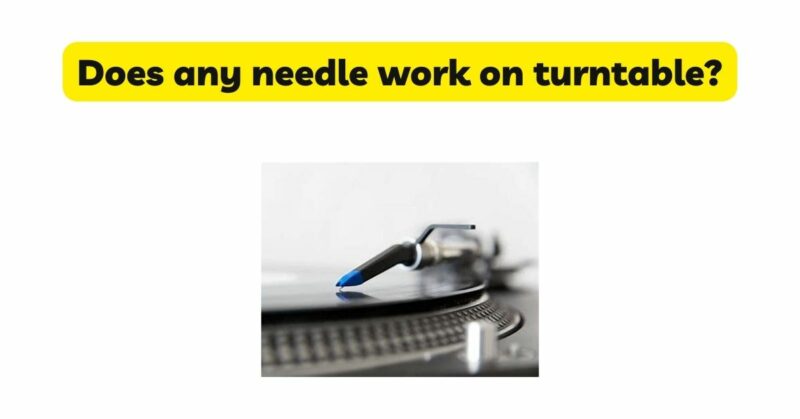Turntables are intricate audio devices that require precision and care to deliver optimal sound quality. The needle, also known as the stylus, is a critical component of a turntable, responsible for tracking the grooves on vinyl records and translating them into audio signals. While it may be tempting to believe that any needle will work on a turntable, the reality is that needle compatibility is essential for proper performance and record preservation. In this article, we will explore the concept of needle compatibility and explain why not just any needle will work on a turntable. Understanding the factors that determine needle compatibility will help you make informed decisions when selecting a needle for your turntable.
- Turntable and Cartridge Compatibility: Turntables utilize different types of cartridges, each with unique specifications and requirements. The cartridge is the housing that contains the needle and electrical components responsible for generating the audio signal. Needle compatibility is closely tied to cartridge compatibility. Factors to consider include:
a. Mounting Style: Turntables may use various mounting styles for cartridges, such as standard mount, P-mount (T4P), or T-mount. Each mounting style requires a specific type of cartridge and, consequently, a compatible needle.
b. Cartridge Type: Cartridges can be broadly categorized into moving magnet (MM) and moving coil (MC) types. MM cartridges are more common and offer a wider selection of replacement needles. MC cartridges tend to be more specialized and often require specific replacement cartridges rather than just the needle.
c. Electrical Characteristics: Cartridges have electrical specifications, such as output voltage and impedance, which affect compatibility with amplifiers and phono preamps. It is important to consider these specifications when selecting a needle to ensure proper signal transmission and compatibility with your audio system.
- Stylus Profile and Groove Compatibility: The stylus profile refers to the shape of the needle tip that tracks the grooves on the vinyl record. Different stylus profiles offer varying levels of precision and sound quality. Common profiles include:
a. Conical: Conical stylus profiles have a rounded shape and are the most basic and affordable option. They provide reliable tracking but may not offer the same level of detail as more advanced profiles.
b. Elliptical: Elliptical stylus profiles have a more elongated shape, allowing for improved tracking and better retrieval of audio information from the record grooves. They generally provide better sound quality compared to conical profiles.
c. Microline (Shibata): Microline stylus profiles feature a narrower and more intricate shape. They offer the highest level of accuracy and detail in tracking the record grooves, resulting in superior sound reproduction. However, not all turntables can accommodate microline styli, as they require precise alignment and setup.
It is important to consider the stylus profile that matches the capabilities of your turntable and cartridge, ensuring compatibility and optimal sound reproduction.
- Tracking Force and Tonearm Compatibility: The tracking force refers to the downward pressure exerted on the stylus as it tracks the record grooves. It is essential to choose a needle that matches the recommended tracking force range specified by the cartridge manufacturer. Each cartridge has a specific range within which it performs optimally. Using a needle with a tracking force outside this range can result in poor sound quality, excessive record wear, or even damage to the needle and records.
Additionally, turntable tonearms have specific requirements for cartridge weight and compliance, which can affect needle compatibility. The compliance refers to the cartridge’s ability to absorb vibrations and follow the undulations of the record grooves. It is important to select a needle that matches the compliance specifications of the tonearm to ensure proper tracking and sound reproduction.
- Manufacturer Recommendations and Guidance: To ensure the best compatibility and performance, consult the manufacturer’s recommendations for your turntable and cartridge. Manufacturers often provide guidelines for selecting compatible replacement needles based on the specific model. These recommendations consider factors such as stylus profile, tracking force range, and electrical characteristics. Following manufacturer guidance ensures proper compatibility and can help optimize the performance and longevity of your turntable and records.
Conclusion: Contrary to the belief that any needle will work on a turntable, needle compatibility is crucial for proper performance, sound quality, and record preservation. Turntables and cartridges have specific requirements, including mounting style, cartridge type, stylus profile, tracking force, and tonearm compliance. These factors determine whether a needle will work effectively and provide optimal sound reproduction. It is essential to consider these compatibility factors and consult manufacturer recommendations when selecting a replacement needle for your turntable. By understanding the importance of needle compatibility, you can enhance your vinyl listening experience, protect your records, and ensure the longevity of your turntable setup.


